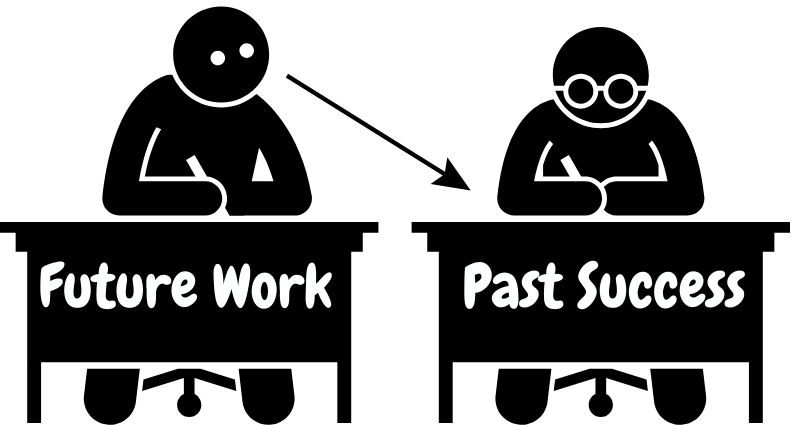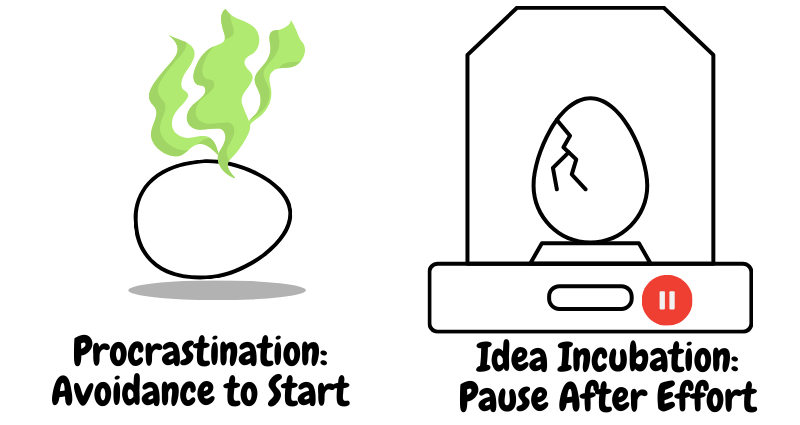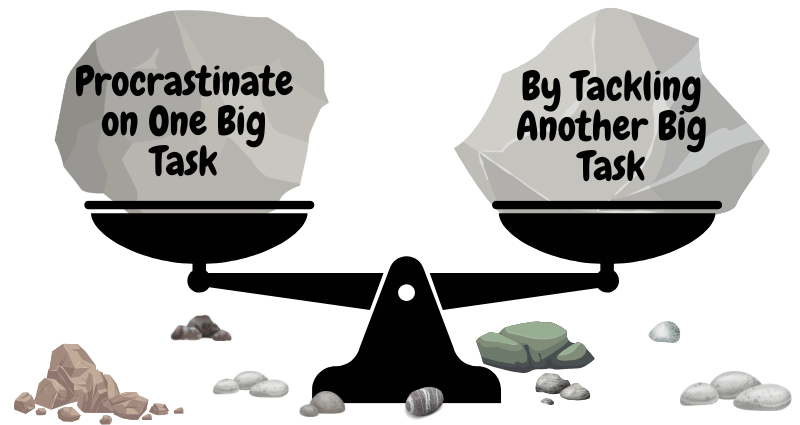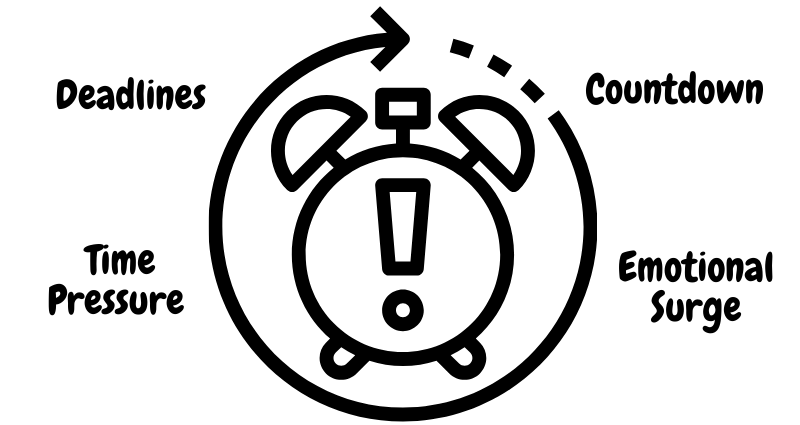Procrastination isn’t all bad. About one-fifth of online articles on procrastination highlight its potential benefits, while the rest focus on strategies to overcome it. Procrastination is everywhere. We’ve all experienced it. And we’ll all face it again.
So, when procrastination shows up next time, what should you do? Fight it? Glorify it? I suggest neither.
Your first step is to avoid procrastination by reverse-engineering your productive flow state.
If it doesn’t work, take step two, which is turning procrastination into idea incubation. This step buys you valuable time for steps three and four.
For step three, view procrastination through the rocks, pebbles, and sand model of time management—strategic, routine, and trivial tasks. If you’re procrastinating on one major “rock” task, redirect your focus to another of equal importance. This way, you’re still progressing in strategic areas and not wasting time.
And finally, step four: set a deadline and leverage the wave of urgency. It is your ticket to finishing strong.
The overall result? You won. Not by resisting procrastination, but by understanding it and working with it.
Now, let’s dive into the details.
Procrastination Pros and Cons
Benefits of Procrastination
Procrastination is often linked to creative insights, more intelligent prioritization, and greater efficiency.
What if procrastination is like an immune system, signalling something isn’t right?
It could tell us we need more time to think, let ideas incubate, or consider a different path. Maybe it’s a warning that we’re too busy, lost in minutiae, and must zoom out.
We don’t need to silence the impulse to procrastinate, just like we shouldn’t reflexively suppress a fever with Advil. Sometimes, it’s there for a reason.
Peter Economy shared with Inc. how procrastination helped him discover his true calling: “When we procrastinate, we are often doing something that we enjoy. This could provide us with a great opportunity to find passions or skills that we did not know about. In my own case, I could have chosen to jump into higher levels of management in my organization, but when I delayed that decision, I began writing books on the side. Today, all I do is write, and I love it—it was my hidden passion when I was a manager.” 1
Procrastination is not always a roadblock to success. Dr. Itamar Shatz compiled a list of eighteen highly successful individuals known for procrastinating, including J.K. Rowling, Bill Clinton, the Dalai Lama, and Steve Jobs. 2
So why does it carry such a negative reputation?
Drawbacks of Procrastination
On the flipside, procrastination can take a toll on mental and physical health and, if unchecked, can erode confidence, success, and overall quality of life.
The procrastination story of Tim Urban is very different from the story of Peter Economy.1,3
Both Peter and Tim procrastinated and turned to activities they enjoyed.
But unlike Peter, who discovered his passion for writing books, Tim spent his procrastination time scrolling aimlessly up and down Google Earth.
“When we procrastinate, we know that we’re acting against our best interests,” says Dr. Piers Steel, a professor of human resources and organizational dynamics, and holder of the Brookfield Research Chair at the University of Calgary’s Haskayne School of Business.4
Procrastination often contributes to mental health issues like heightened stress and anxiety. Constantly delaying tasks can cause pressure and guilt to accumulate, eventually affecting our mental health.
The Lifehack article “8 Ways Procrastination Can Destroy Your Life” outlines how chronic procrastination can profoundly impact various aspects of one’s well-being.5 Procrastination can lead to the formation of limiting self-beliefs, causing us to doubt our capabilities and potential.
This self-doubt often results in missed opportunities, derails personal goals, hinders career progression, and strains relationships.
Four Steps to Manage Procrastination
There’s a wide range of techniques for managing procrastination. Finding what works for you takes experimentation.
What helps others might not help you, and could even backfire.
In this article, I’ll guide you through strategies: what to try, what might work (or not), and why.
Step #1: Activate Your Productive Flow

Productive flow is when you’re completely immersed, focused, and working at your best. You often lose track of time because you’re so engaged in what you’re doing.
It feels effortless, yet you’re doing deep, meaningful work at a high level of performance.
Before starting an important task, take a moment to reverse-engineer your productive flow by asking yourself:
- When have I completed a similar task quickly and successfully?
- What resources or techniques supported my success?
- What environment or conditions supported me at the time?
Your path to productive flow state might be as unique as you are.
Let me share an example.
One of the most common tips for managing procrastination is eliminating physical and digital distractions. But that doesn’t work for me.
I don’t scroll mindlessly and like having my phone nearby to experiment with background music.
My productivity soars when children and laughter surround me. When things quiet down and I find a few hours for focused work, I know it’s time to go all in. That’s when I find myself slipping naturally into intense, productive flow.
Contrary to my experience, Maya Angelou rented a hotel room where she would write daily, completely isolated from distractions at home.6
Bestselling author James Clear leaves his phone in another room during his focused time to avoid mindless scrolling and interruptions.7
Gabby Bernstein, a renowned spiritual teacher, taps into her flow with a cozy cup of coffee with frothy nut milk.8
Take a thoughtful, organized approach to discover your formula for achieving a productive flow state.
Create a table on paper or digitally, with several specific examples of times you experienced productive flow state.
In one column, list these moments of flow.
In the adjacent column, capture the key details of each productive flow-state experience by using the categories and guiding questions listed below.
| Category | Questions |
| Time | What was the time of day, day of the week, and month of the year? |
| Companionship | Was I working alone or with others? |
| Location | Was I at home, in an office, or somewhere else? |
| Sounds | Was it silent? If not, what kind of background noise or sound was present? |
| Food and Drinks | What did I eat or drink during that time? |
| Sleep | Did I feel well-rested? |
| Mood & Special Events | How did I feel? Did anything significant happen before or during that period? |
Now, try to find patterns and common themes of your creative flow states and recreate them.
Step #2: Transform Procrastination into Idea Incubation

If your productive flow feels out of reach, try transforming procrastination into ideas incubation.
Graham Wallas, co-founder of the London School of Economics, introduced the concept of idea incubation in 1926. Wallas proposed that after gathering information about a problem or idea, we should step away and allow our subconscious mind to continue working in the background.
The word “procrastination” comes from the Latin procrastinate, pro meaning “forward” and crastinare meaning “until tomorrow.”
Although both procrastination and idea incubation involve a pause in active effort, their outcomes differ greatly.
Procrastination often leads to missed opportunities and failure, while idea incubation frequently produces breakthrough insights.
How can we flip the switch and transform procrastination into idea incubation?
As poet and creative coach Mark McGuinness explains, procrastination is avoiding the start of work, while incubation is the pause that follows intense effort, often after hitting a wall. 9
This concept of idea incubation is supported by the Zeigarnik effect, named after Russian psychologist Bluma Zeigarnik.10
Through her experiments, Zeigarnik discovered that our minds continue to work on unfinished tasks subconsciously. This is a slower but often more effective process than active problem-solving.
When the initial work is behind you, you will find yourself paying attention to things related to your problems, noticing patterns you hadn’t seen before, and slowly piecing together solutions.
The key is to get started and keep showing up. 11
Common examples of tasks people procrastinate on include studying for exams, writing reports, exercising, and making important decisions.12 It’s easy to feel overwhelmed by these tasks.
To reduce the pressure of “eating an elephant”, tell your mind that all you need are small bites to keep your mind engaged in the background.
Step #3: Trade One Big Task for Another

Now, let’s dive into what we do when we procrastinate.
Peter Economy wrote books when he procrastinated on his management duties. On the contrary, Tim Urban procrastinated scrolling around Google Earth instead of preparing his TED Talk.1,3
For Tim, procrastination was unproductive waste of time. For Peter, procrastination was a door to a new more exciting chapter in his career.
Let’s look at this through the lens of the rocks, pebbles, and sand time management model.
Rocks represent strategic, high-effort tasks. We tend to procrastinate the most on rocks. Pebbles are smaller, more manageable tasks that require little mental energy. Sand represents trivial activities.
In the examples above, Peter shifted his focus from one rock to another rock, while Tim filled his rock time with sand.
This food analogy makes procrastination choices easy to understand. If your child refuses to eat broccoli (your healthy-food rock), you wouldn’t want mashed potatoes (pebbles) or potato chips (sand) within her reach. Instead, you’d offer her a variety of other healthy vegetables (rocks) to choose from.
Similarly to this food analogy, before embarking on an important task, always plan a fallback option for moments when you hit a wall, need a break, or lose momentum. These fallback options should be your other “big rocks”.
For instance, when you got stuck on writing a report, you can shift to creating an annual plan (another “big rock”). You can also switch to running, cycling, working out, spending time with loved ones, or meditating to recharge your energy and get back on track. Health, well-being, and key relationships are always big rocks.
Step #4: Harness the Power of Urgency

A sense of urgency is a powerful catalyst that sharpens focus, speeds up decision-making, and pushes us beyond what we believe is possible.
John Kotter, author of The Sense of Urgency, famously wrote: “A higher rate of urgency does not imply ever-present panic, anxiety, or fear. It means a state in which complacency is virtually absent.”
Consider a few examples. During the COVID-19 pandemic, teachers worldwide rapidly transitioned to remote learning, mastering digital tools they had never used before.
In hackathons, intense, time-bound innovation challenges, teams typically have 24 to 48 hours to build working prototypes. This compressed timeline helps participants avoid distractions and “perfection traps,” allowing innovation to flourish.
Here are several effective strategies to turn urgency into a driving force for productivity:
Set Artificial Deadlines. If there are no deadlines, break large tasks into smaller, manageable chunks and assign each a mini-deadline. Schedule these before the due date to create a controlled sense of pressure.
Simulate Time Pressure. Use techniques like Pomodoro (25-minute focused sprints) to mimic the urgency of last-minute work.14 Short, timed bursts can trigger the same focus that procrastination often delivers.
Leverage Visual Countdown Tools. Incorporate countdown timers, calendar reminders, or progress bars to create a visible sense of time slipping away. These cues activate your brain’s urgency response and prompt quicker action.
Leverage Emotional Surge. Notice the emotional surge of procrastination. Instead of avoiding it, use that energy to jumpstart action. Begin with one small, simple step to break the inertia.
Key Takeaways
- Procrastination is often misunderstood and unfairly labelled as purely negative. On the positive side, procrastination may indicate the need for reflection, a course correction, uncover hidden passions, and even enhance creativity and decision-making.
- However, the darker side of procrastination shouldn’t be ignored. Procrastination can lead to increased stress, guilt, and self-doubt, undermining mental health and overall life satisfaction. It may also sabotage personal goals, career growth, and relationships, ultimately eroding confidence and success.
- One of the most effective ways to manage procrastination is to reverse-engineer your past productive flow states. Take a structured approach to identify the conditions, such as time, environment, energy levels, and companionship, that support your deep focus. Look for patterns and try to recreate those conditions.
- Procrastination and idea incubation involve stepping back, but with different results. Procrastination delays starting and risks losing opportunities, while incubation follows effort and leads to insights. To shift procrastination into incubation, start taking efforts, no matter how small.
- Always look at procrastination through the lens of the rocks (strategic work), pebbles (routine work), and sand (trivial job) time management model. When you procrastinate, trade tasks within the same priority level. For instance, if you procrastinate on a big task (rock), pivot to another high-value task (another rock) rather than slipping into low-priority work (pebbles or sand).
- If procrastination sets in, leverage urgency as a productivity tool. Set artificial deadlines, use countdown timers, or use the emotional pressure to jumpstart action. A sense of urgency can sharpen focus, accelerate decision-making, and push you beyond perceived limits.
FOOTNOTES
- In his Inc. article, The Unexpected Benefits of Procrastination: A Deeper Dive, Peter Economy argues that procrastination, when approached thoughtfully, can offer surprising advantages. One of the most interesting examples is that the author discovered a hidden passion for writing by procrastinating on a management promotion. Writing ultimately became Peter’s fulfilling full-time career.
- In his website, Solving Procrastination, Dr. Itamar Shatz, a researcher at the University of Cambridge, highlights how many renowned individuals have struggled with procrastination. While some still succeeded, Shatz cautions against romanticizing the habit, noting its frequent downsides like stress, guilt, and missed opportunities.
- Tim Urban’s popular TED Talk, Inside the Mind of a Master Procrastinator, uses humour to explain procrastination through vivid metaphors like the “Instant Gratification Monkey” and the “Panic Monster.” Boasting over 75 million views, it’s one of history’s most popular TED Talks.
- Piers Steel’s quote is taken from Kerry Banks’ article “The Pull of Procrastination” in University Affairs, which explores the issue of procrastination in academic settings.
- In her Lifehack article, “8 Ways Procrastination Can Destroy Your Life,” productivity coach Kirstin O’Donovan outlines how procrastination can harm success and overall well-being.
- The Idler article “Working from Bed” explores Maya Angelou’s writing routine, highlighting her practice of renting a modest hotel room near her home to write early in the morning, free from distractions.
- In her CNBC article “Bestselling ‘Atomic Habits’ author shares his No. 1 rule for more productivity,” Morgan Smith highlights James Clear’s top productivity advice: putting away your phone for deep work.
- In episode 384 of her podcast, Amy Porterfield discusses the process of writing a book with New York Times bestselling author Gabby Bernstein, including Gabby’s writing rituals.
- In his article “What’s the Difference Between Incubation and Procrastination?” on Wishful Thinking, creative coach Mark McGuinness distinguishes between two often-confused states in the creative process. Mark’s core idea is that procrastination involves avoiding work altogether, , while incubation is a pause after meaningful effort.
- The article “Zeigarnik Effect” on Psychology Today explores the psychological phenomenon where unfinished or interrupted tasks are more likely to be remembered than completed ones.
- In his article “How to Stop Procrastinating by Using the 2-Minute Rule,” James Clear explains that the key to overcoming procrastination is taking consistent action, even very small ones, because showing up regularly builds momentum and new identity.
- Steven Handel’s article “50 Common Things We Procrastinate On,” published on The Emotion Machine, presents a comprehensive list of tasks that people frequently delay.